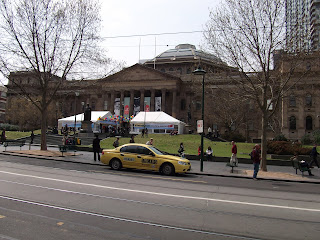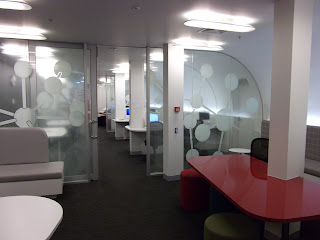Australian universities are facing the same feedback challenges as the UK. Students are similarly dissatisfied with the quality, timeliness and burden of feedback, and this reflects in their equivalent of the NSS. Colleagues I’ve spoken to have felt that TFA! was a refreshing change in trying to encourage student use of feedback and they particularly liked the student voice in the research and the student guide to using feedback.
Many of their universities have similar staff development and e-learning support configurations to Sheffield Hallam. Central units with decentralized support within the groups (faculties) to give them a sense of ownership and just-in-time support. However communication between central and group support needs a great deal of effort.
Current work around e-learning include looking at how well Blackboard is embedded in the curriculum through staff surveys and LMS usage data, some ‘forced’ uptake of the VLE, the use of mobile technology, getting time-poor staff (and not the usual suspects) to engage in professional development for e-learning use self-help materials rather than relying on one-to-one support. There is concern about the amount of effort resources take to create, yet no-one actually looks at them.
Webinars and lecture-captured workshops (Echo360 is the current favourite) are often used instead of face-to-face sessions for two main reasons. (1) it’s seen as fair go on multi-campus universities where lengthy car journeys between sites is the norm so that more staff can participate or use them at their convenience, and (2) support staff can point staff at these resources in lieu of time-consuming one-to-one support.
Learning environments (FD) staff take an interest in Blackboard and the day-to-day challenges facing teaching staff by working closely with e-learning support colleagues. They are also very student-focused and from what I’ve witnessed there are ongoing campus building works to improve student-flow and communal areas by replacing uninspiring concrete with gardens, covered-seating areas and cafes. There is a trend towards vibrant and colourful libraries rather than learning centres, and the introduction of ‘writing centres’ for educational guidance.
And finally a few travel tips if you’re planning a trip over here (and perhaps a reminder for next time):
- Declare everything on arrival. It’s the quickest way to get through quarantine and into Australia.
- At touchdown in Bangkok, Hong Kong or wherever your stopover airport is, don’t buy any refreshments for the flight. Even after security screening, all hand luggage is searched on re-boarding and liquids and food confiscated.
- Choose a flight that lands as soon after night curfew as possible. Land at 6am at Sydney for example and you’ll be at the front of immigration. (And you’re likely to be adjusted to Australia time due to sleeping on the night flight).
- If arriving in a quiet little place like Cairns on a Sunday, don’t expect 24/7 shopping, bars and restaurants (and that goes for Mondays too).
- And there’s none of that vulgar English vocabulary for vegetables. It’s all capsicum, eggplant and zucchini.
- Temperatures vary immensely, especially at this time of year: warm days, cold nights. Cairns is consistently hot though. Next year’s BbSummit will be held in Melbourne two weeks earlier, so technically it will still be winter, and I doubt there’ll be frolicking by the pool at the client appreciation party.





































